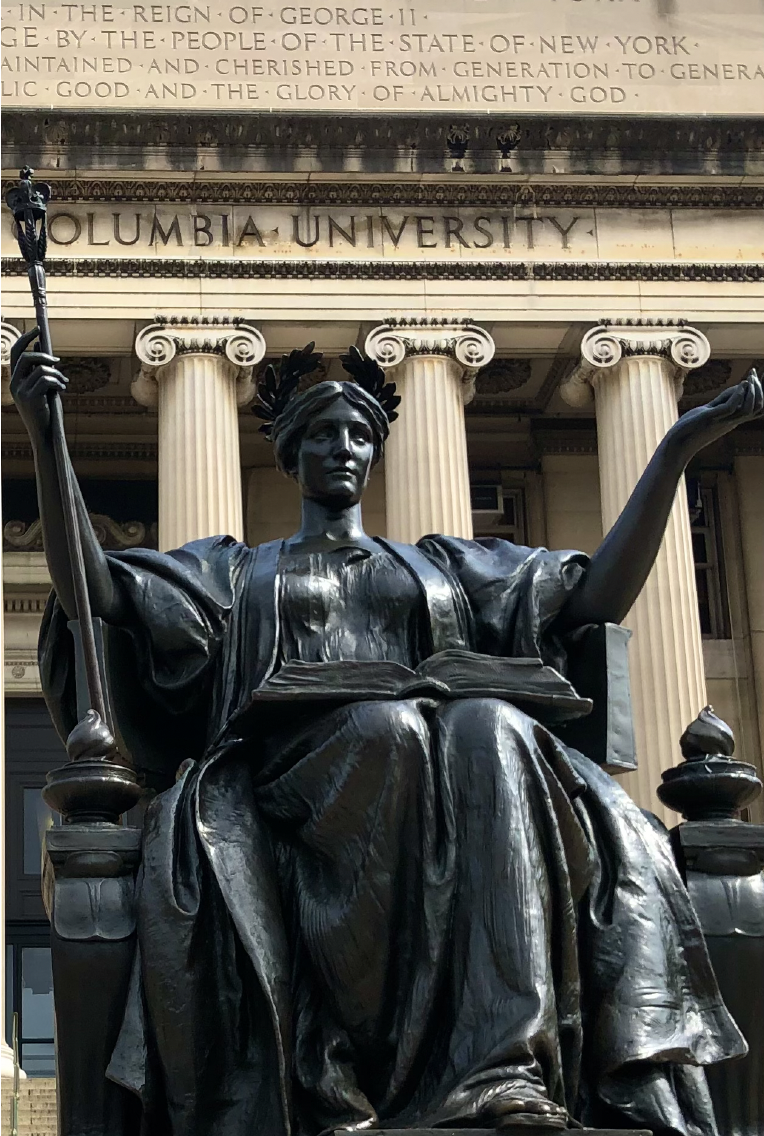Photography by Shalini Kudinoor
Can you tell Alma is a Virgo?
On September 22, 2023, Columbia’s Alma Mater turned 120 years old, and she hasn’t aged a bit. With the celebration of her birthday, I think we all deserve to know a little bit more about her.
Alma Mater got her name from the motto “Alma Mater Studiorum” or “nourishing mother of studies.” A phrase many of us are familiar with upon graduating from an educational institution. The idea of a “nourishing mother of studies” appealed to the ears of Samuel Johnson, Columbia’s first president. Alma first appeared in the university seal designed by Johnson. The board of Trustees described Alma as a symbol of “womanhood” and “motherhood.” With the emergence of America as a country, Alma changed to an active mother, educating her children to become future national leaders (making it very suitable that Alma sits near two libraries).
With her growing importance as the image of the college, the university sought to have her presence on campus. In the 1890s, once Columbia moved from Midtown to Morningside Heights, then-president Seth Low noticed the campus looked a little bare. According to the Columbia archieves, historian Micheal Richman believes the college intended on placing a statue in front of Low Library because campus plans indicated a slab of granite fit for a statue to sit (pun intended). But the spot remained bare for some time.
It wasn’t until 1900 that Harriette Goelet, the widow of Robert Goelet (CC ‘1860), sent a letter asking the Trustees that a statue of Alma Mater be erected in his honor. If the trustees agreed, Mrs. Goelet agreed to fund it. Alma’s presence and the inscription bearing Robert Goelet’s name behind her are evidence her request passed, unanimously. They selected sculptor Daniel Chester French, who was known for many outdoor sculptures, including John Harvard on Harvard’s campus. One of France’s most well-known sculptures, the Statue of the Republic, has an uncanny likeness to Alma. The Statue of the Republic’s beauty, strength, power, and Greek flair were exactly what Columbia wanted to depict Alma Mater. Columbia hoped the bronze statue would grace her presence on campus by the 1902 Commencement. However, it wasn’t until classes began on September 22, 1903 that President Butler unveiled the 8-foot tall Alma. This makes Alma’s place in front of Low Library looking at Butler only suiting, as Low oversaw her creation and Butler, her completion. Alma totaled up to be $20,000. Talk about an expensive woman.
Alma wears a graduation gown referencing one’s educational journey, wielding a crown-tipped scepter of wheat, referring to King’s College. French placed Alma on a throne for her to overlook her kingdom; of course, no queen is without her throne and her pupils at her feet.
Legend has it that there is an owl in Alma’s cloak. I confirmed this is true. French hid a small owl, symbolizing knowledge and learning. The Columbia site notes the owl’s location is an “irreverent detail” on French’s part, as one must look in her skirt. Though true, the owl’s secrecy only makes Alma that much more special and the spitting image of Athena, the Greek goddess of wisdom with her owl companion. It certainly is fun to see who Columbia lore states whoever finds the owl will become valedictorian and marry a Barnard woman. Though dated, if someone with the gumption to look for the small owl in the intimidating superpower that is Alma, maybe they are worthy enough to be blessed with a strong Barnard woman in their life.
Alma Mater remains one of the most famous symbols of Columbia, if not surpassing Roaree the Lion. A strong woman encouraging us to pursue our education, obtaining as much wisdom as Athena, only seems fitting for a school with such a close relationship with Barnard.

